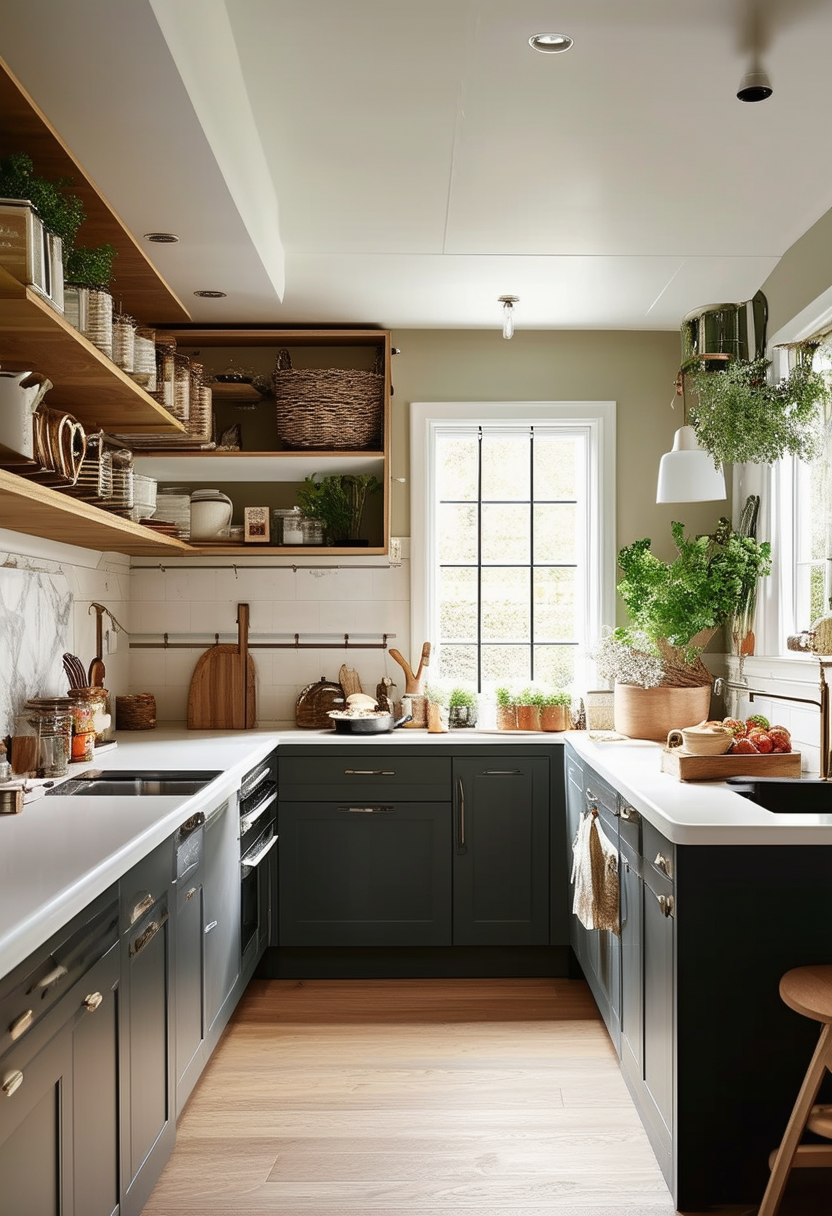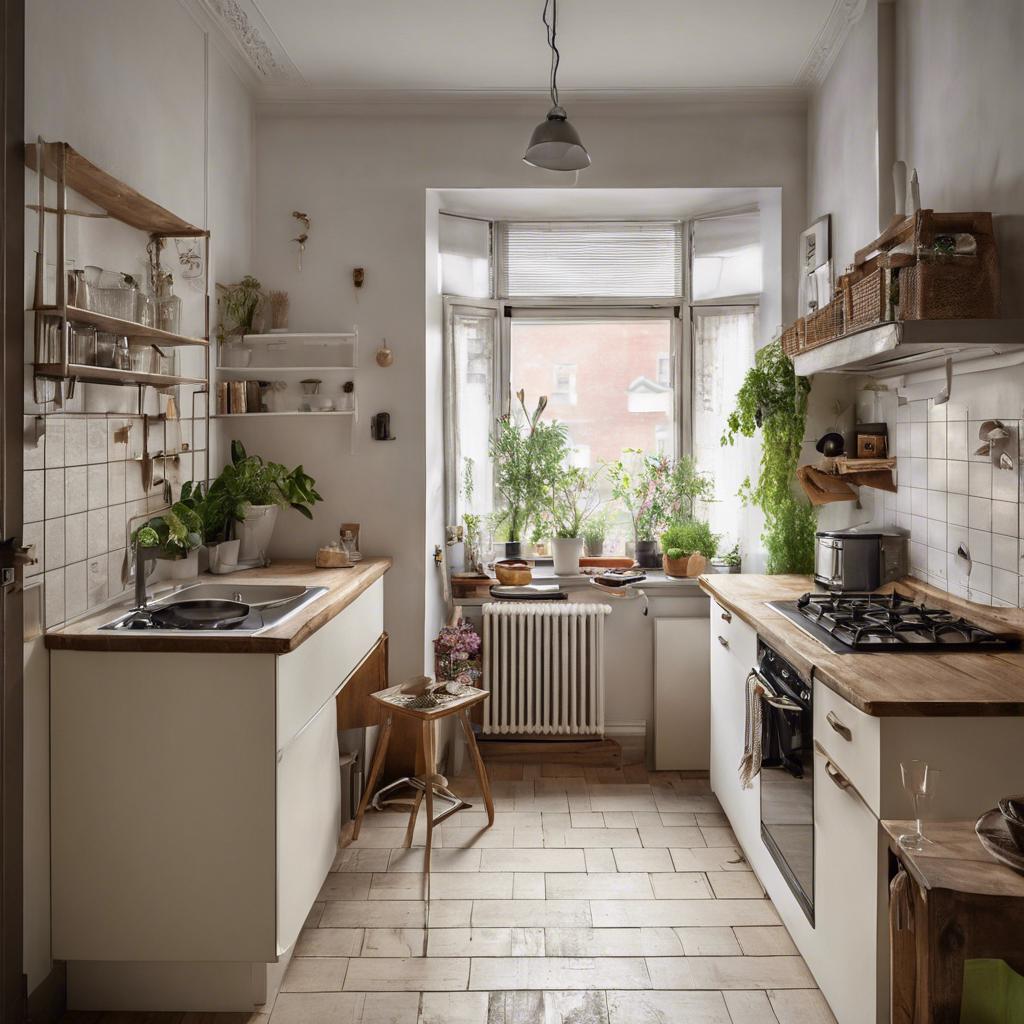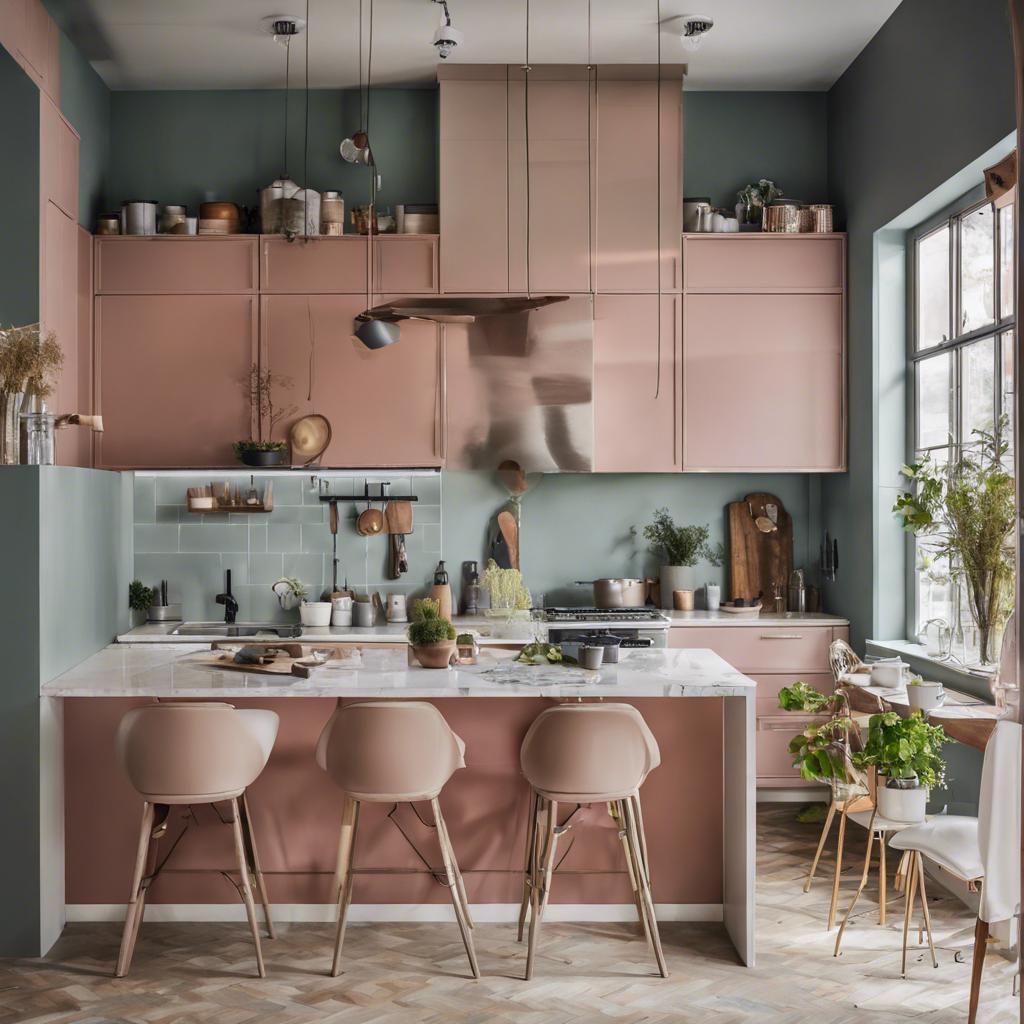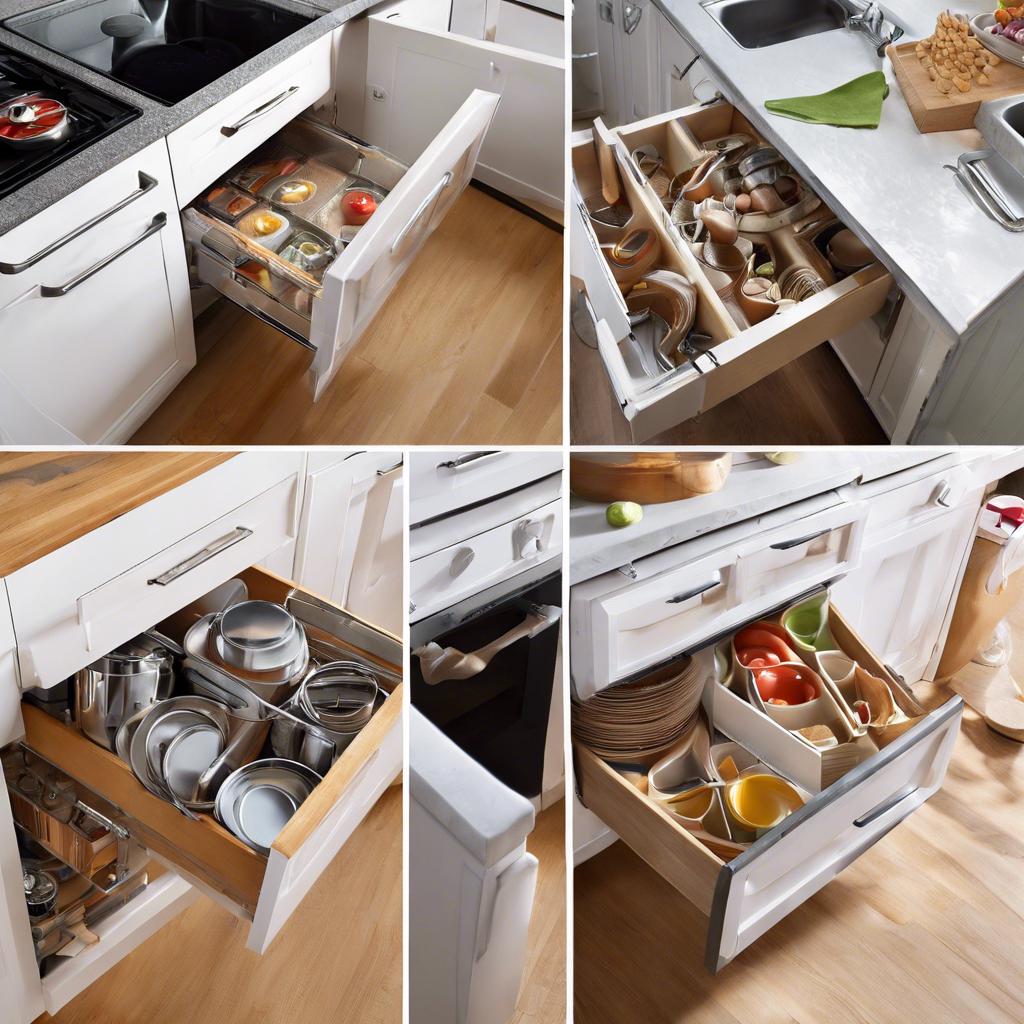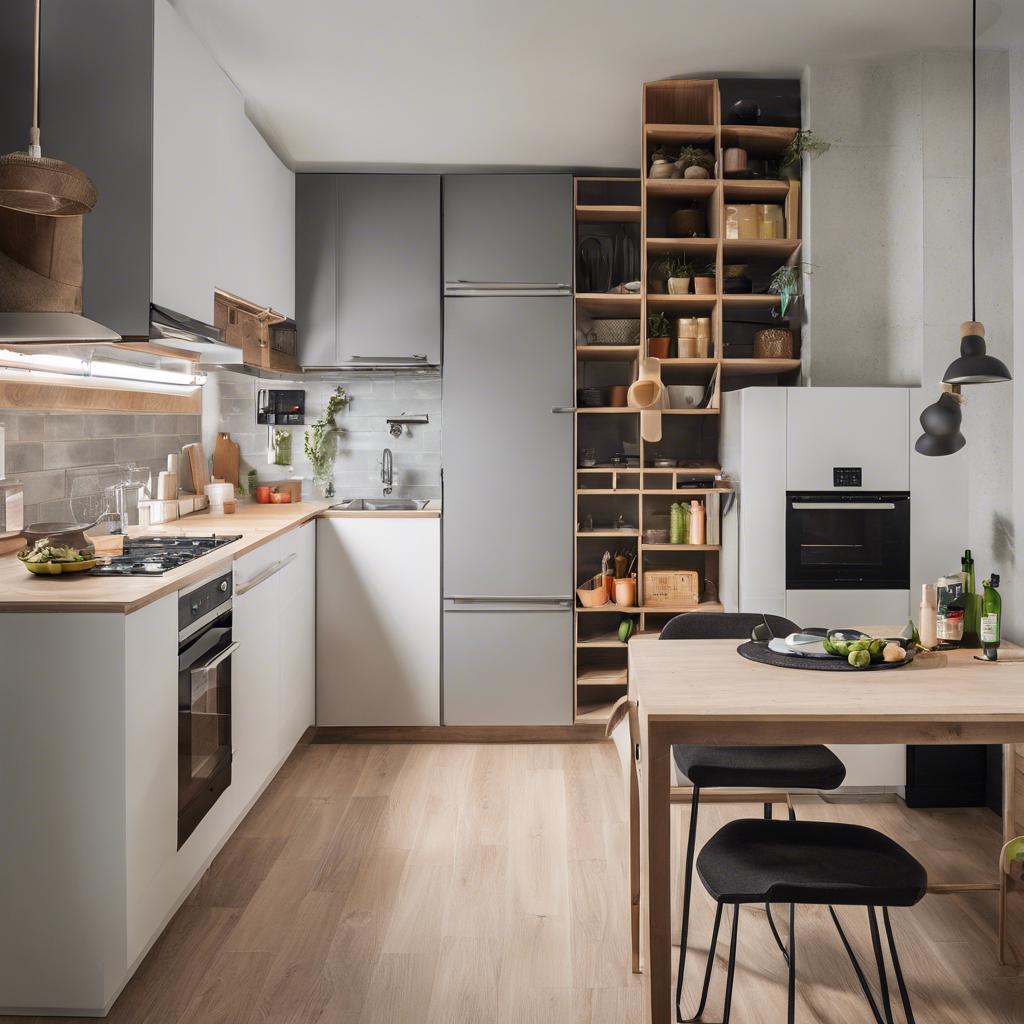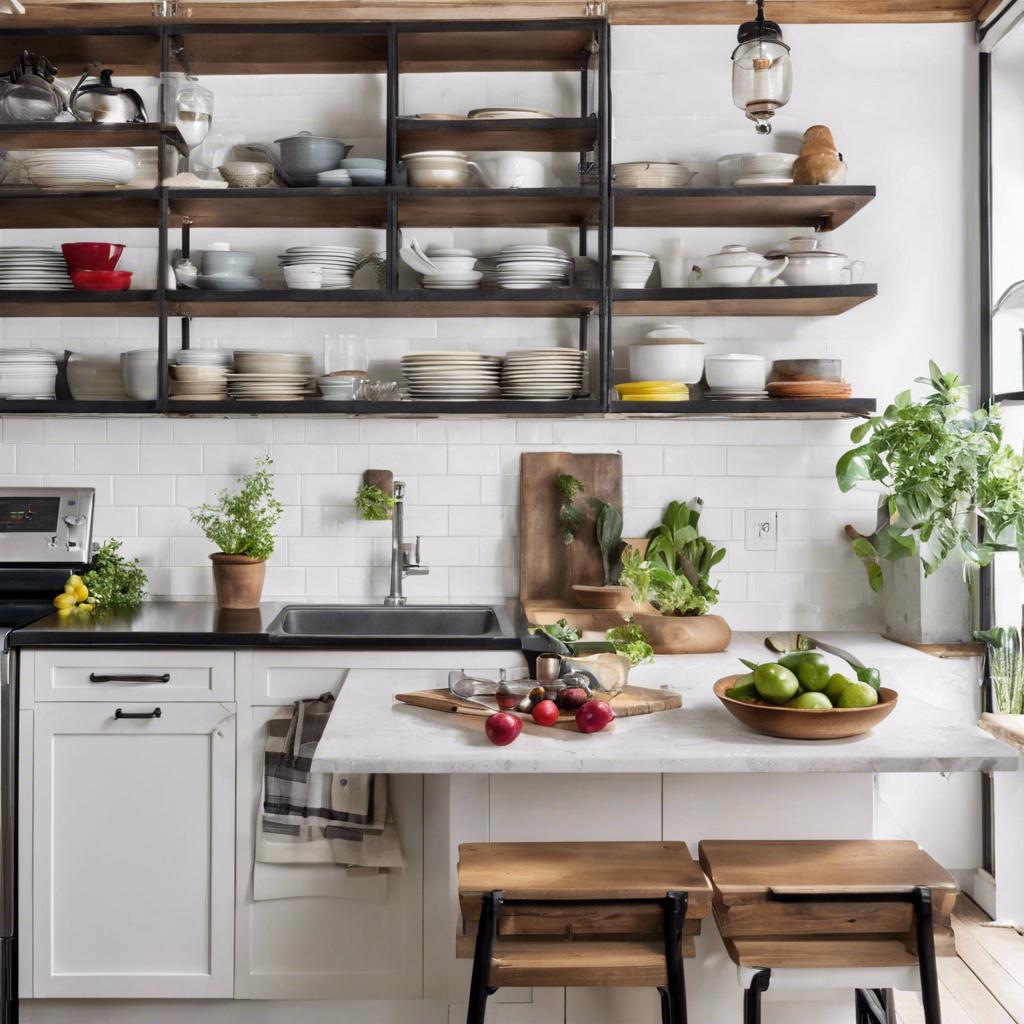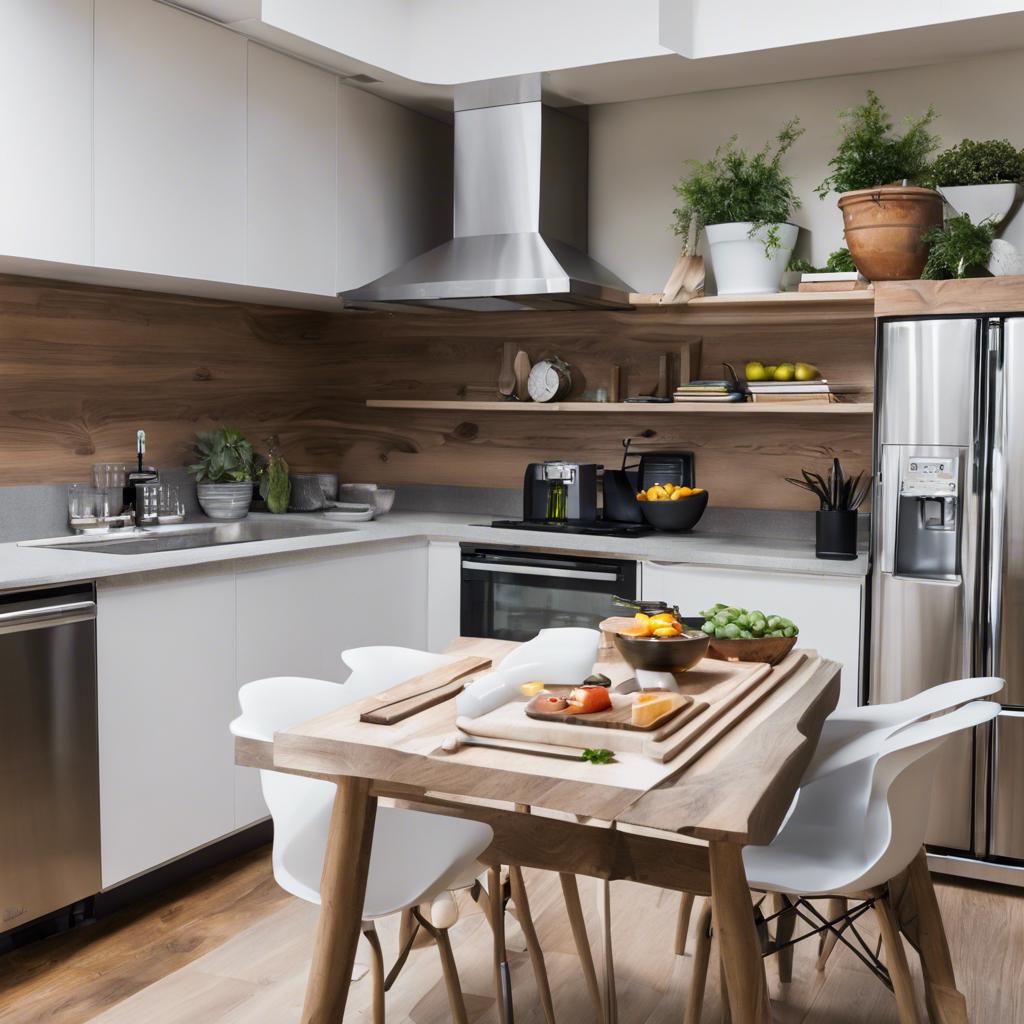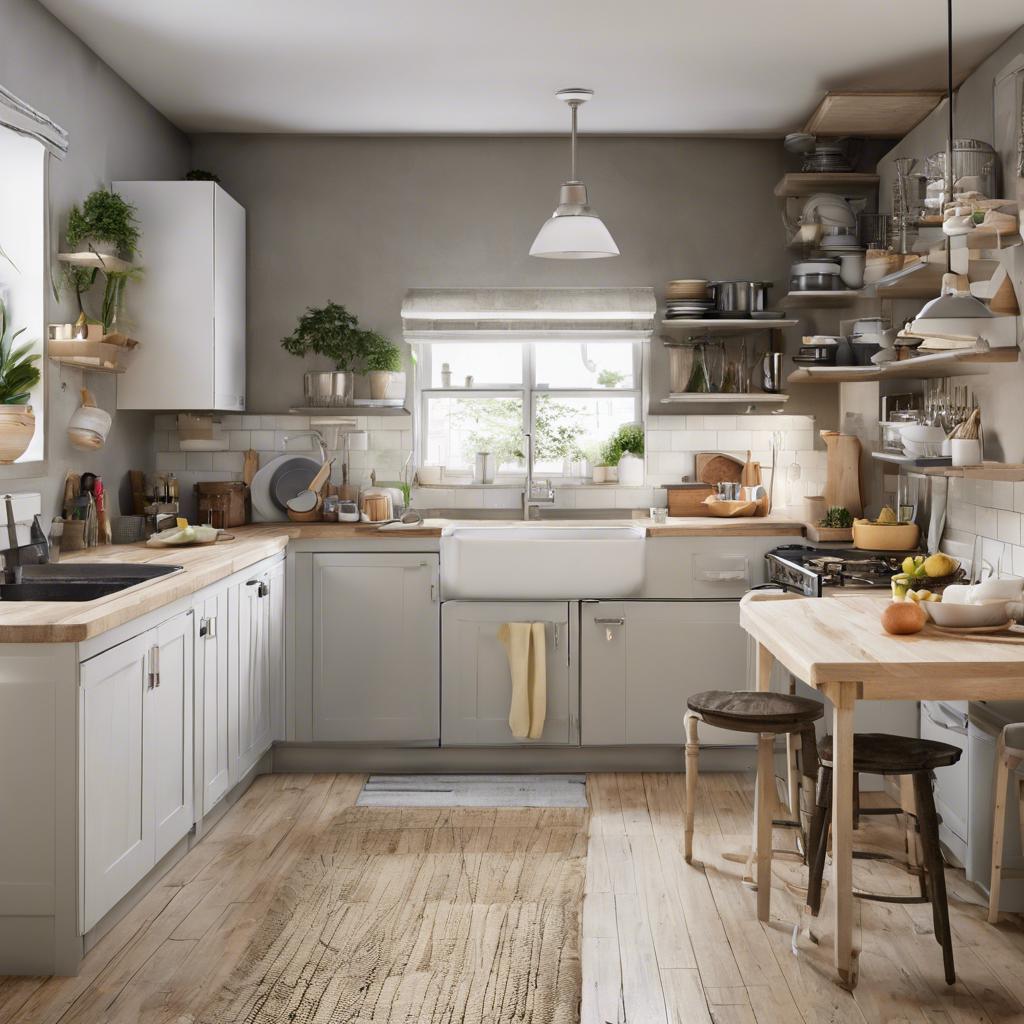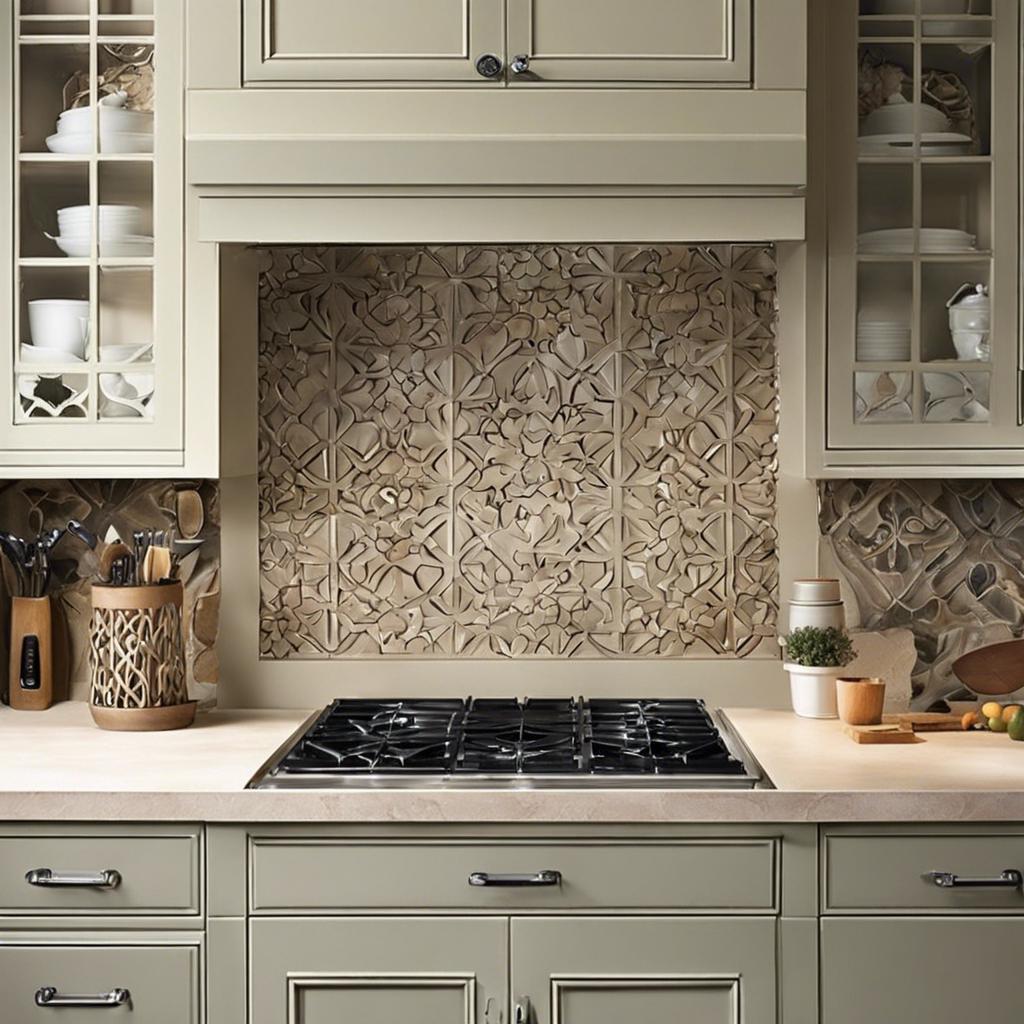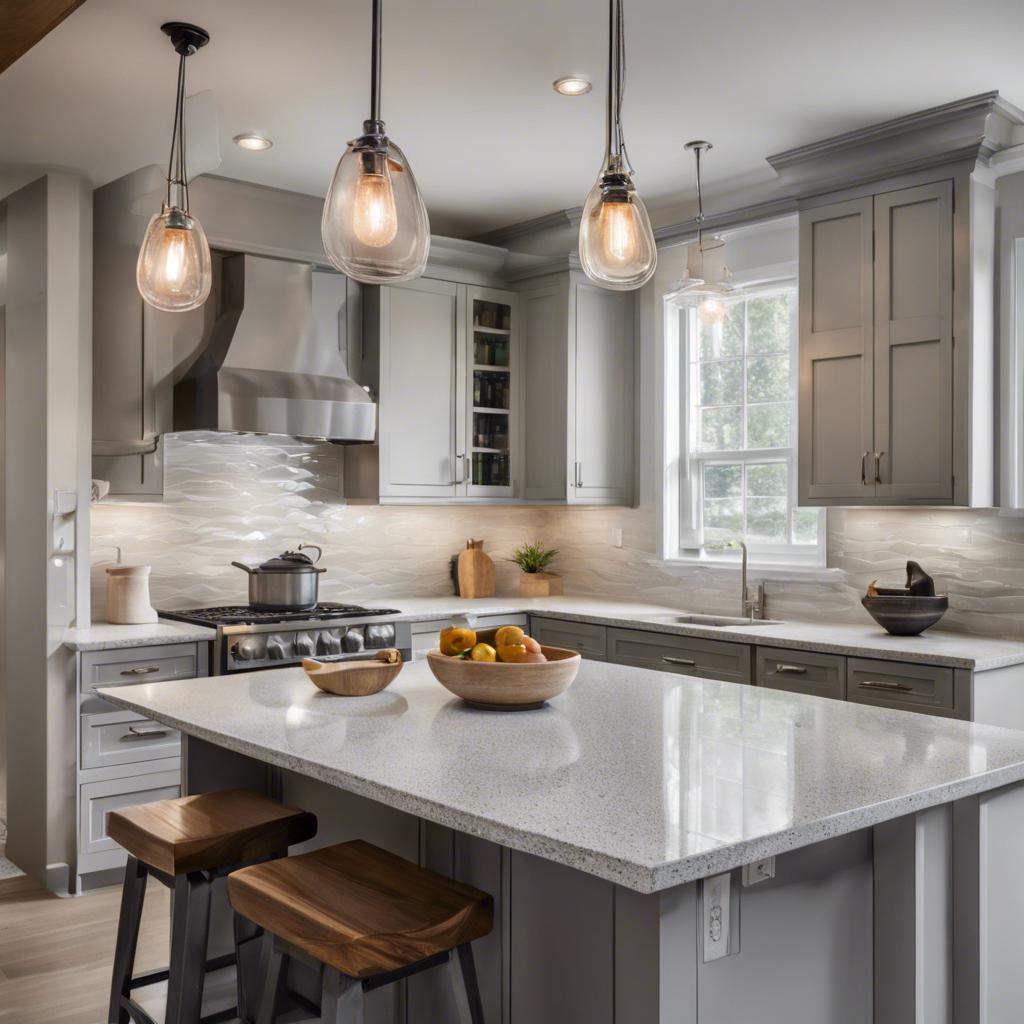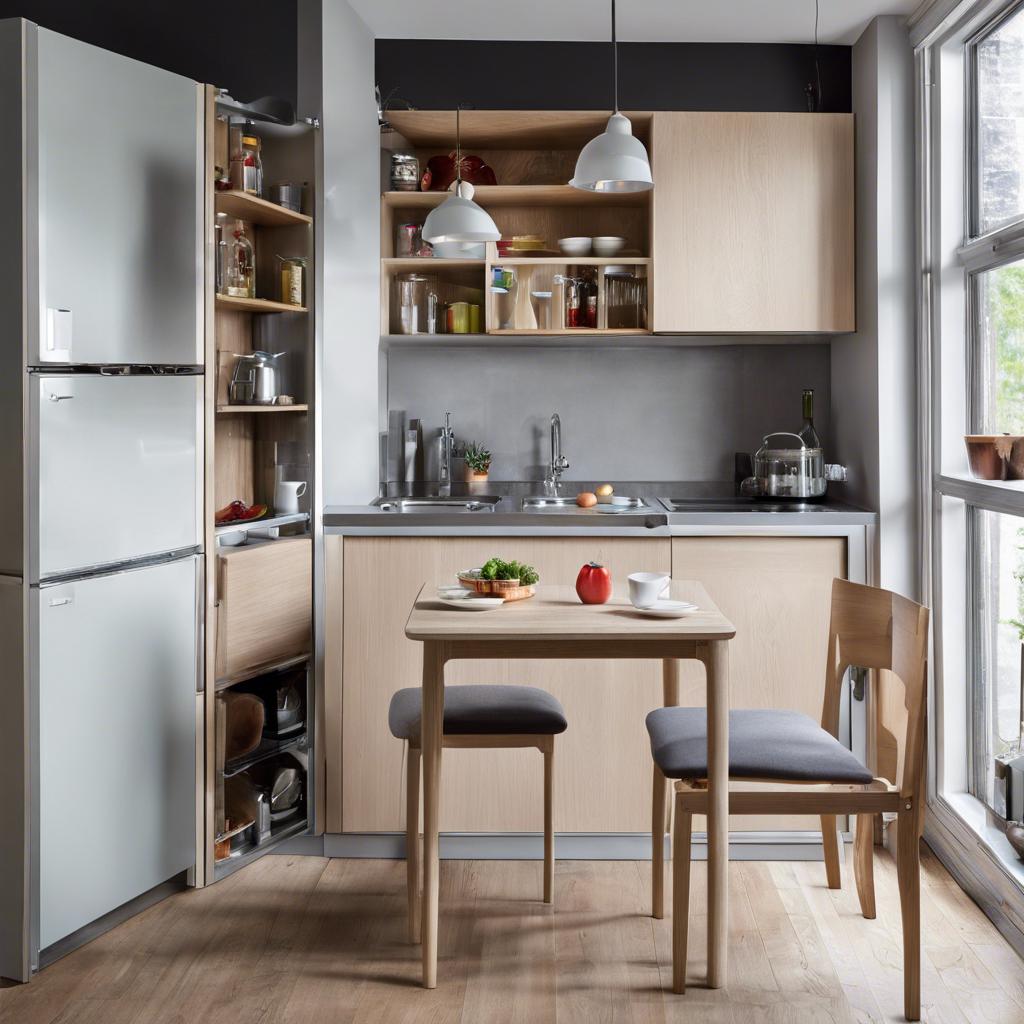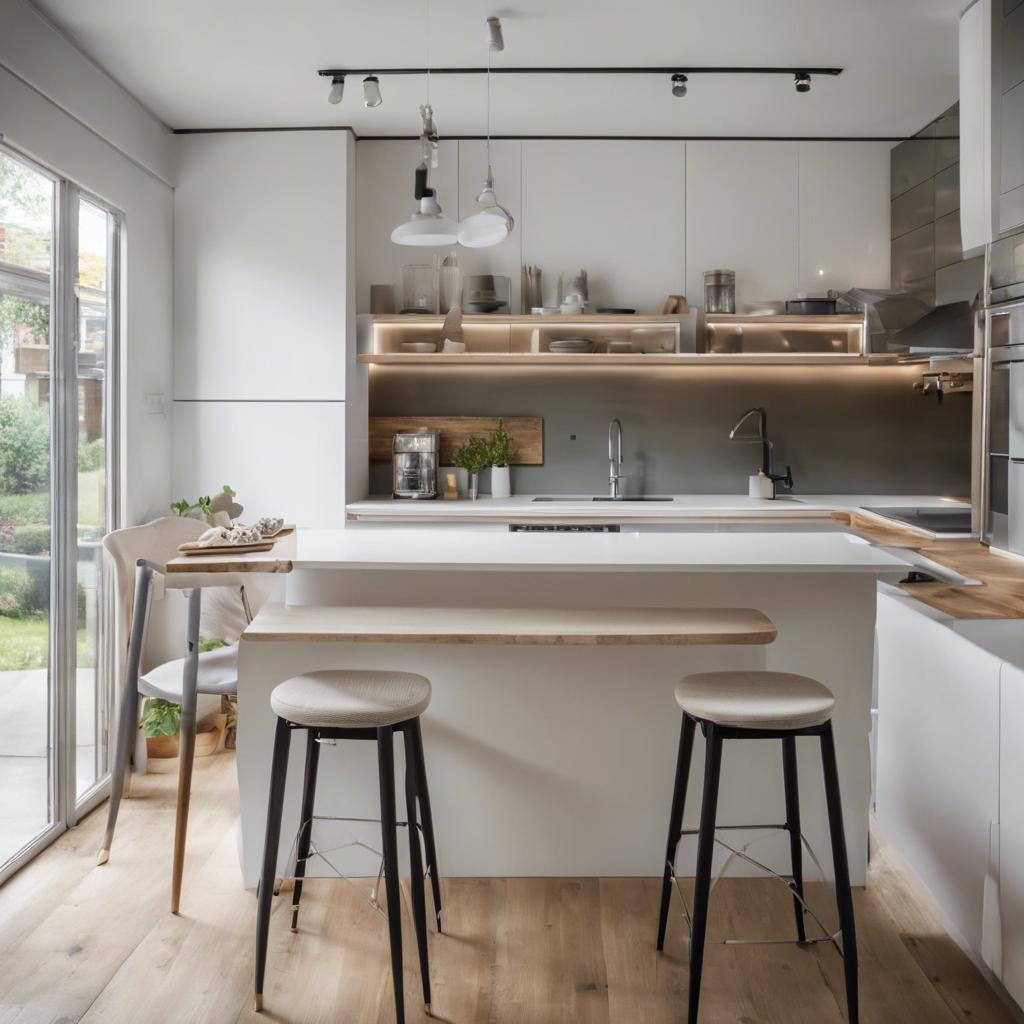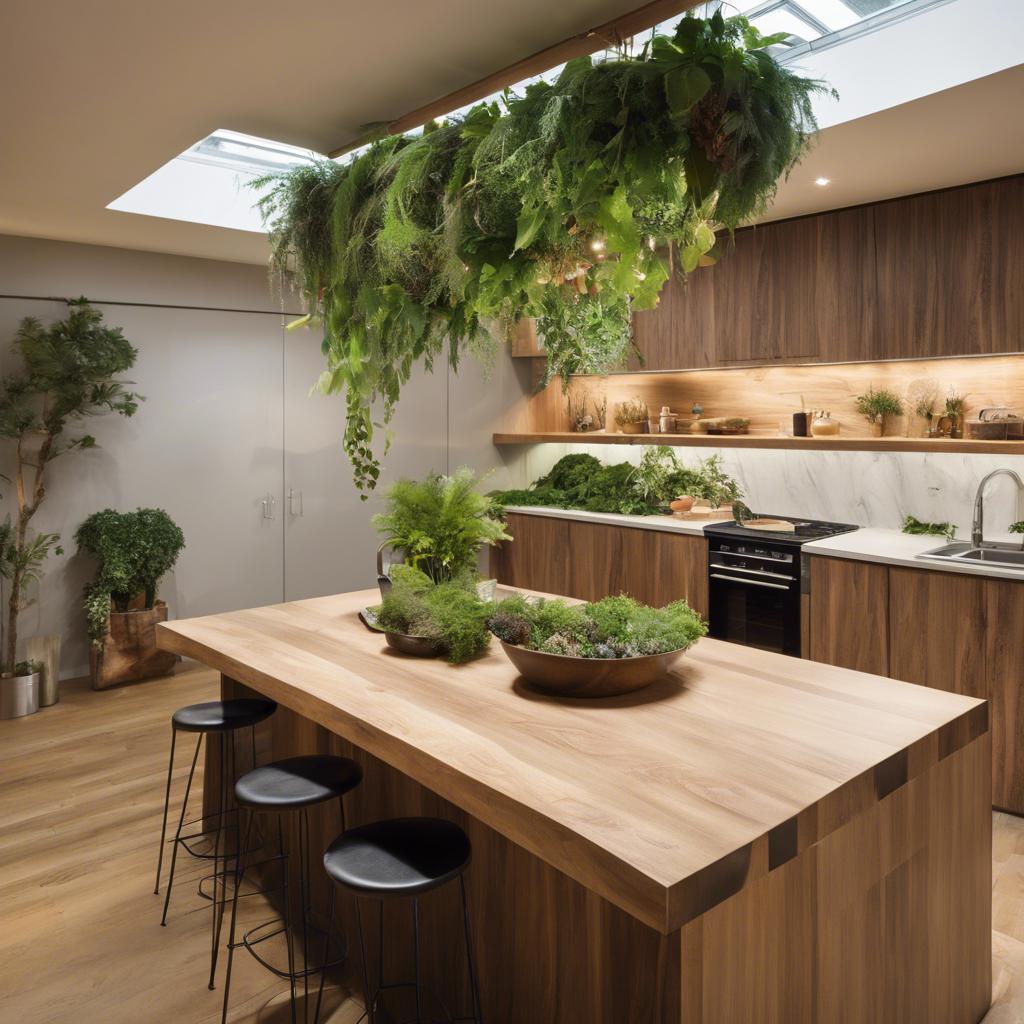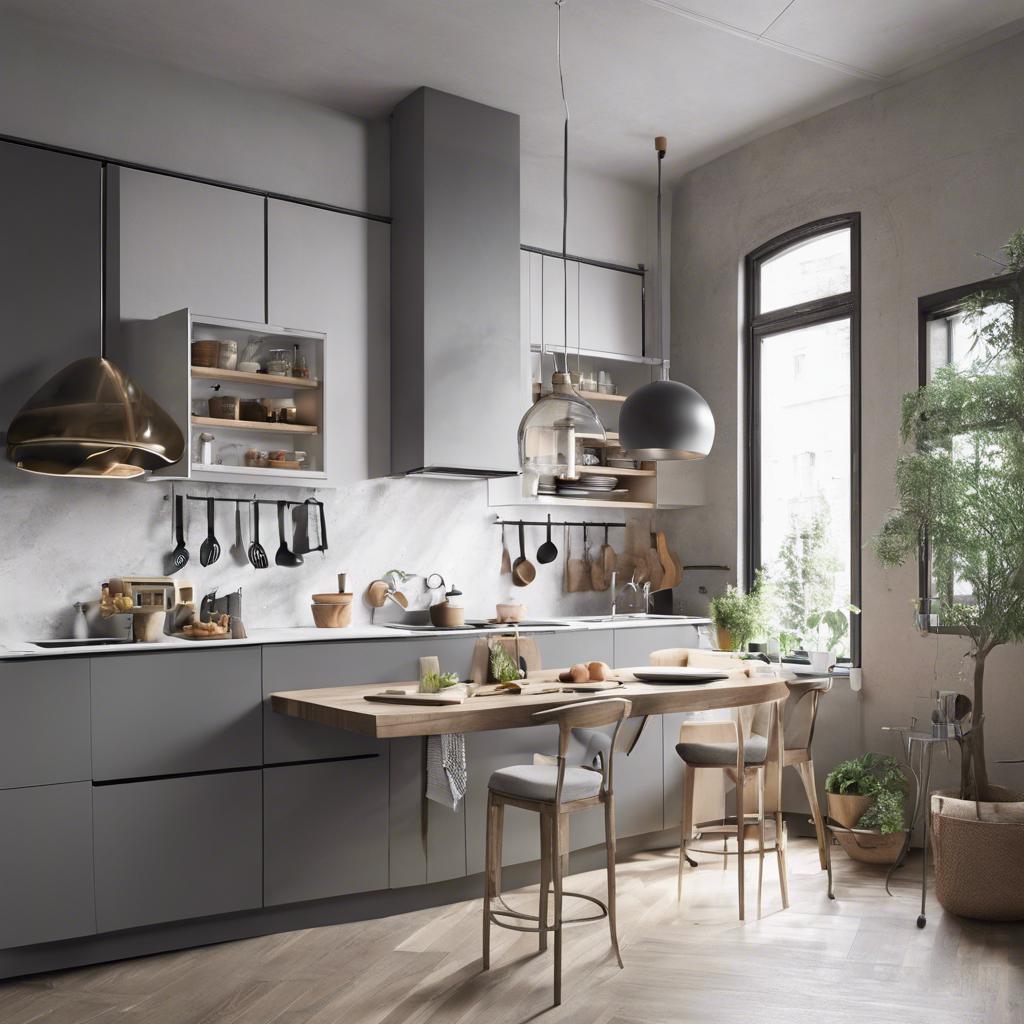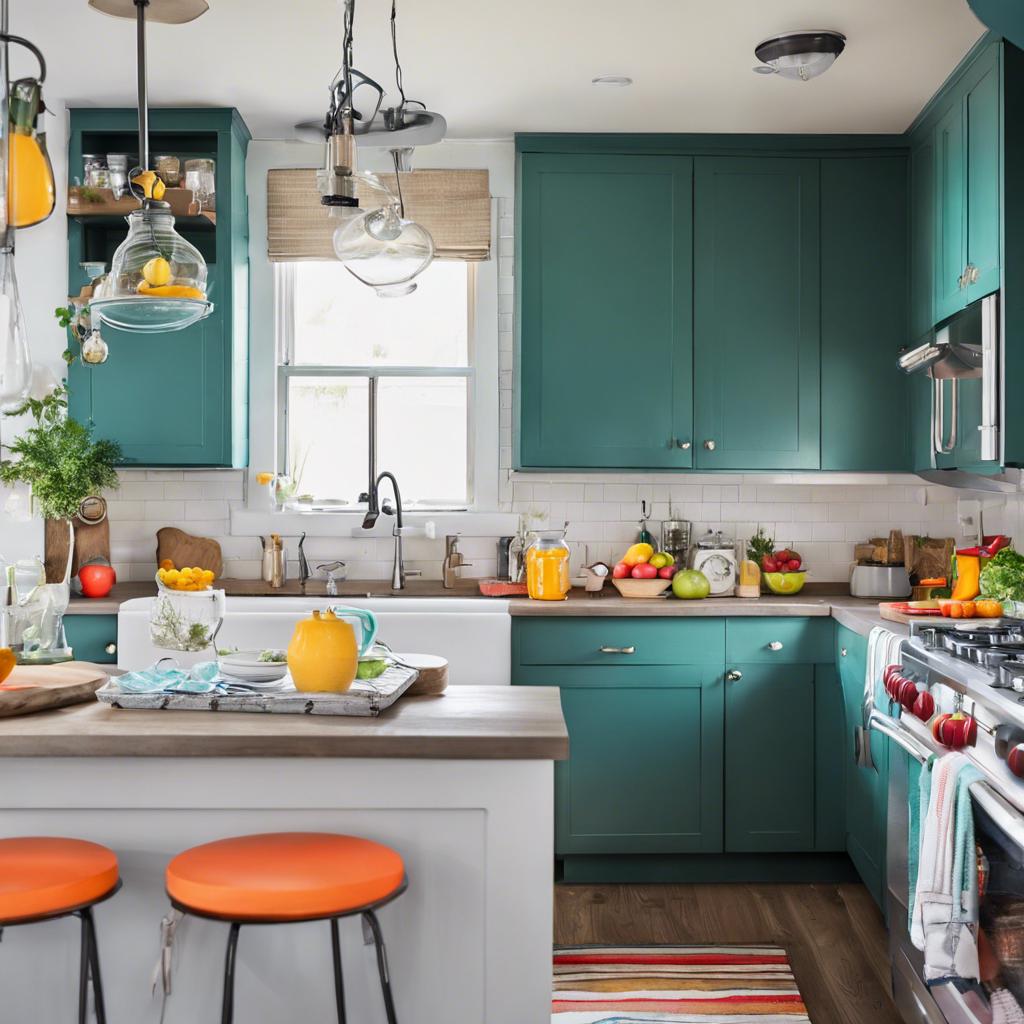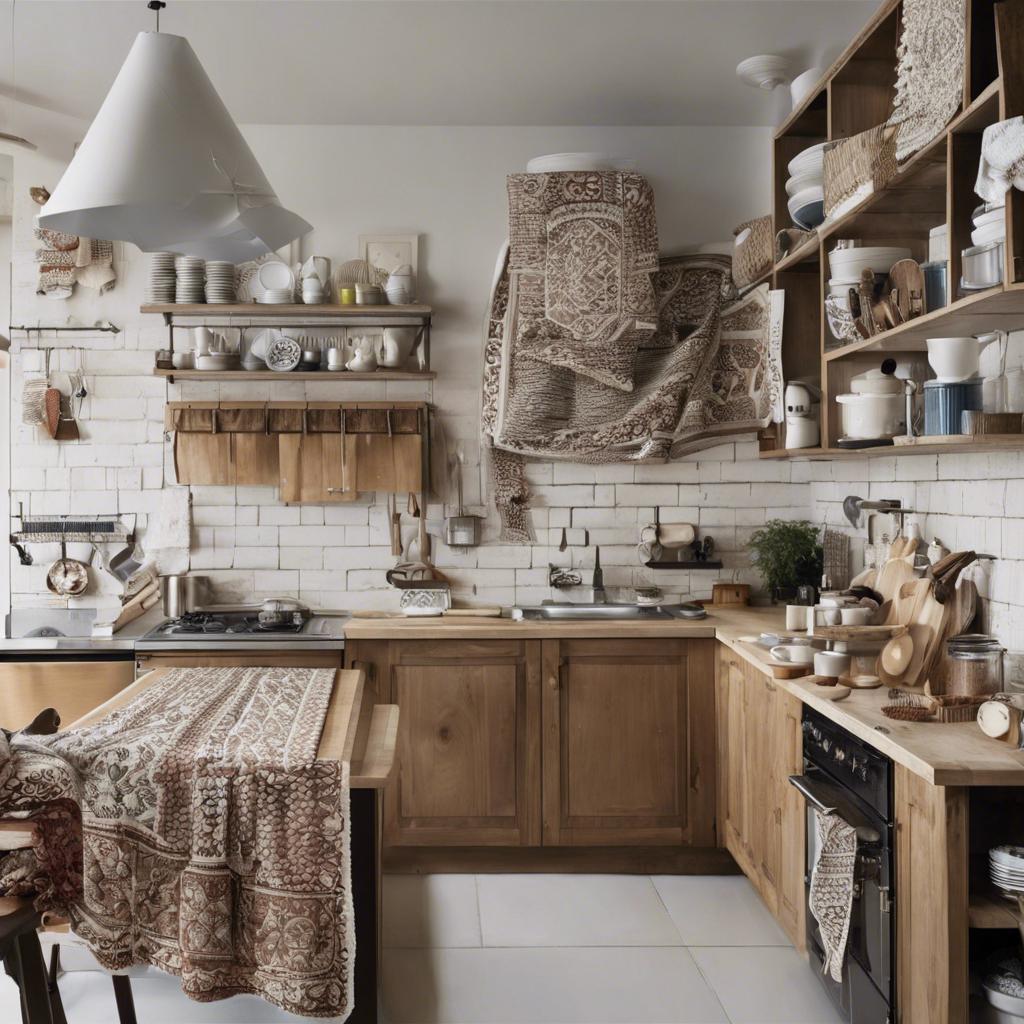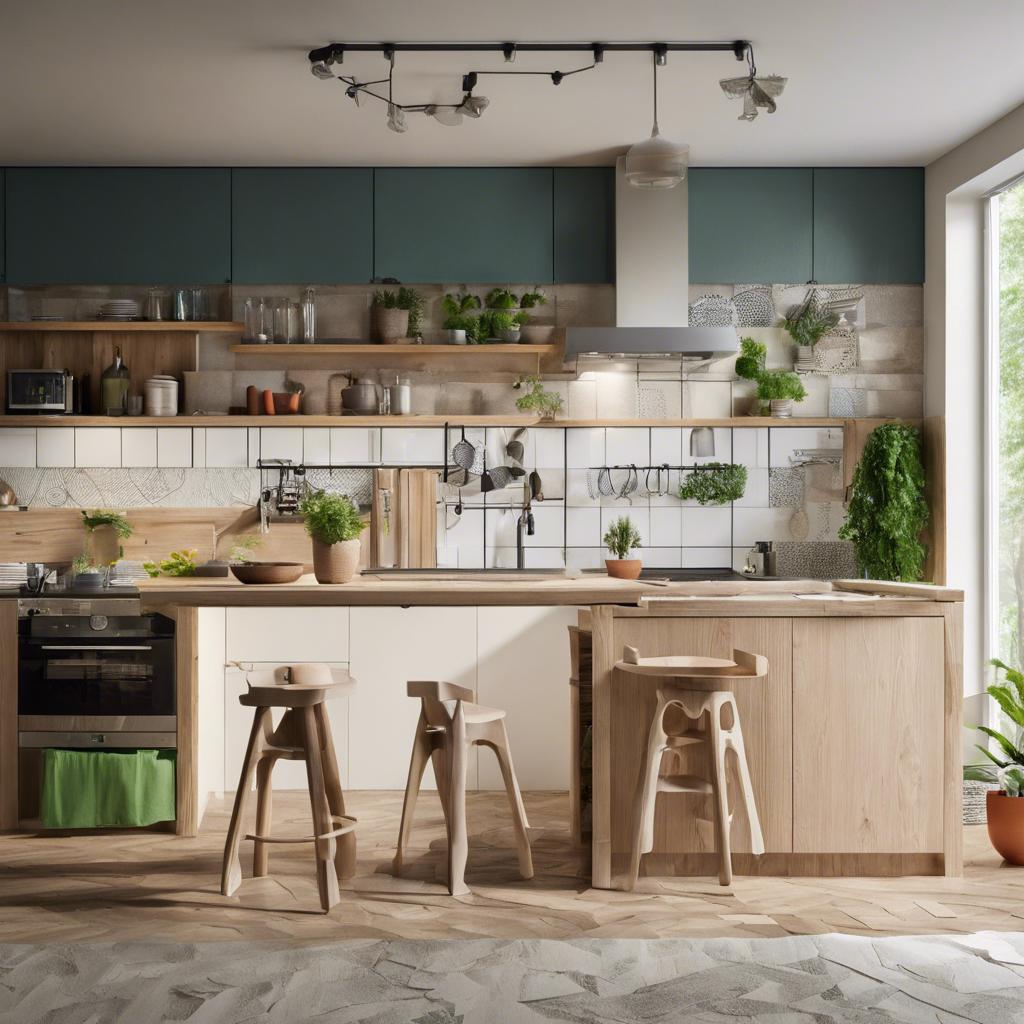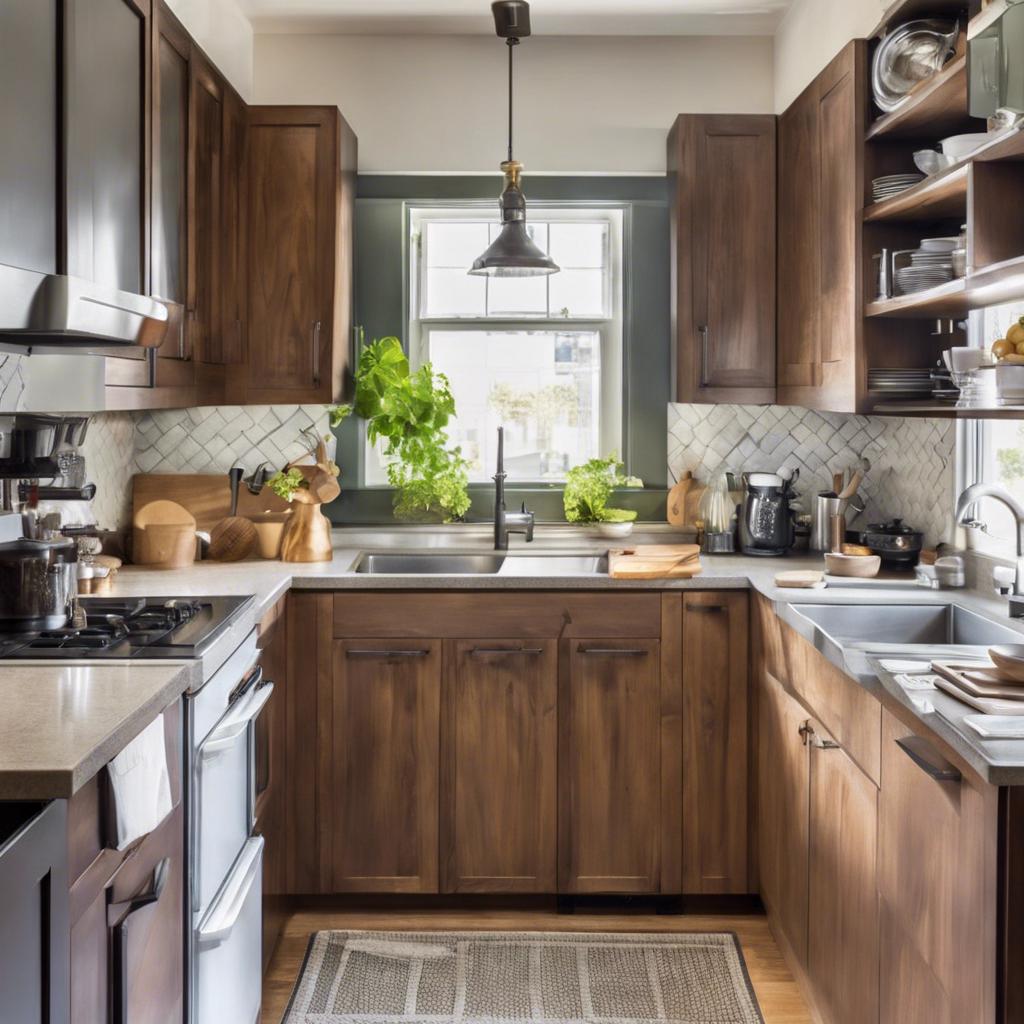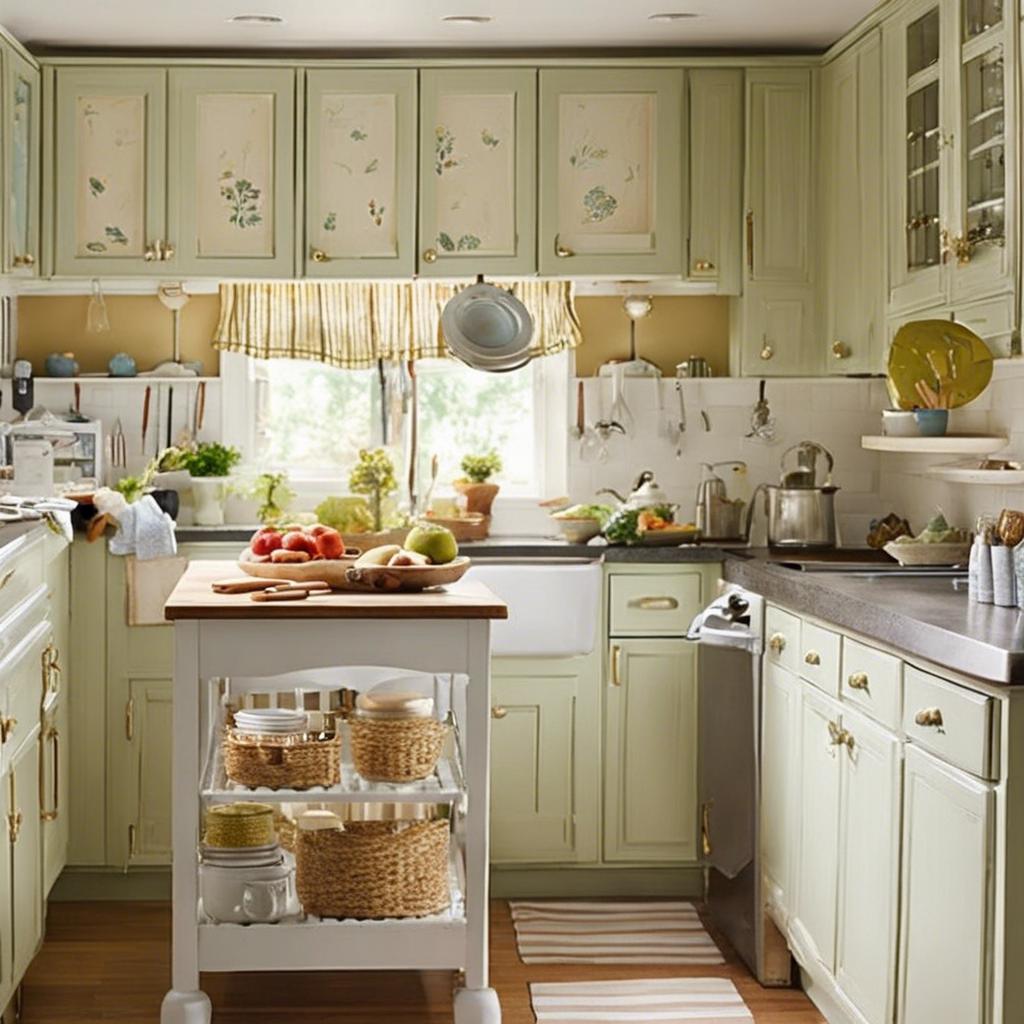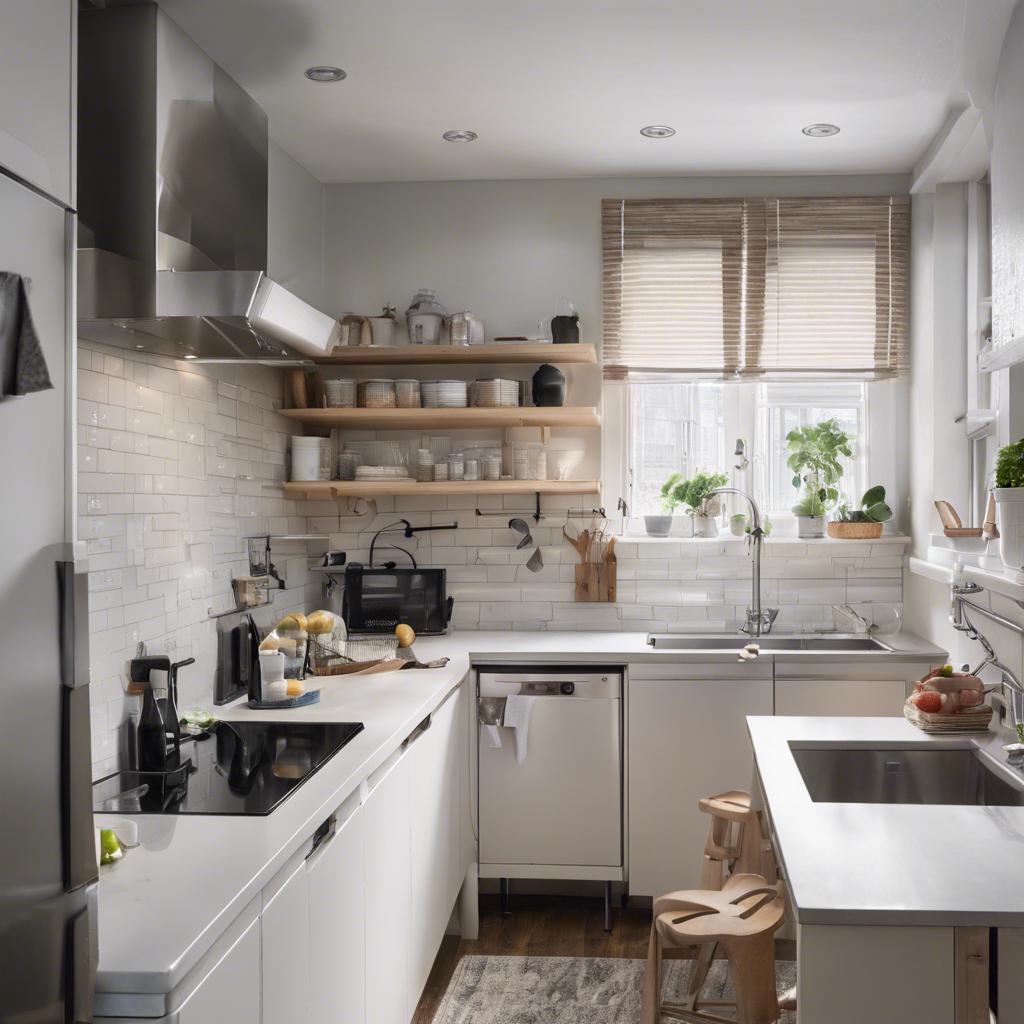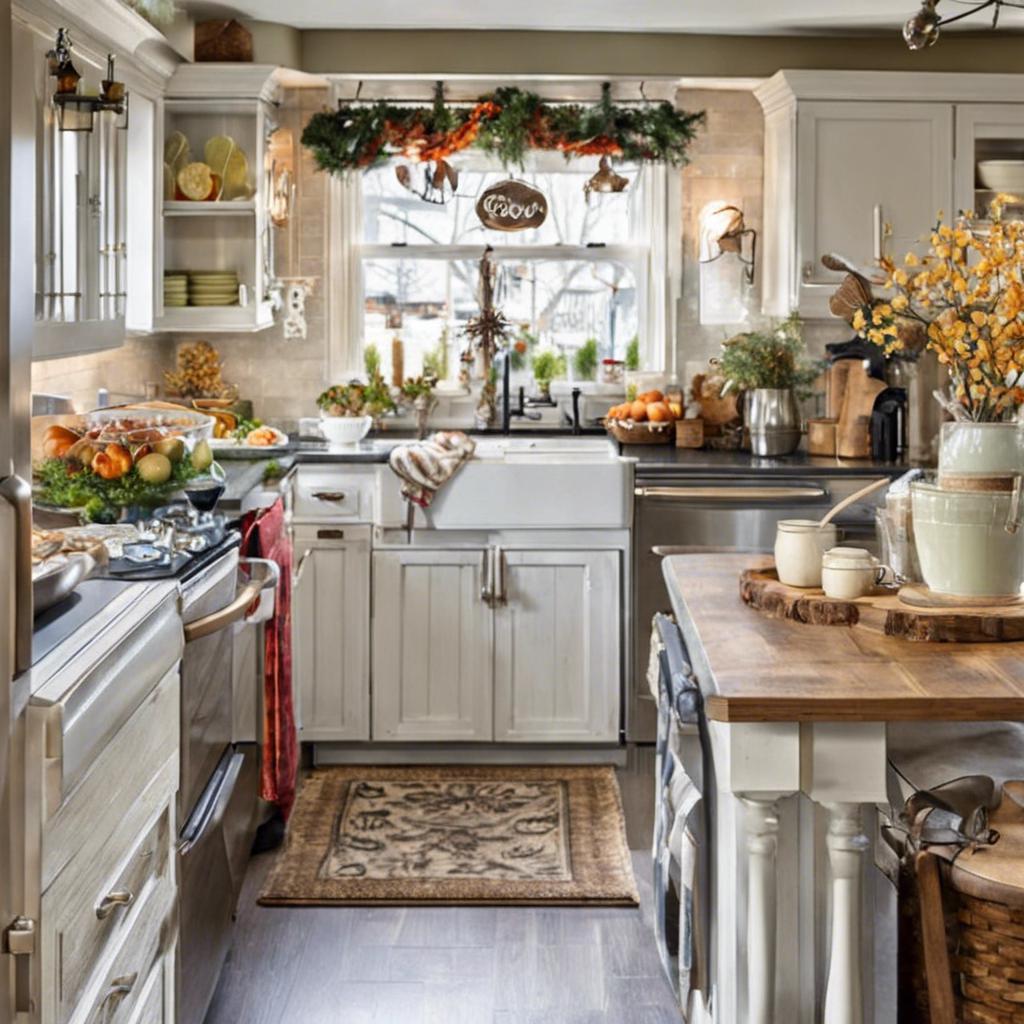In the heart of every home lies the kitchen, a space not only for culinary creations but also for the mingling of ideas, flavors, and family bonds. Yet, for many, the dream kitchen remains just that—a dream. Small kitchens often present unique challenges, where every square inch counts, and creativity must dance hand in hand with functionality. But fear not! With a dash of innovation and a sprinkle of style, even the coziest of kitchens can transform into a chic, inviting masterpiece. In this article, we’ll explore ingenious ideas and practical tips for maximizing style in small kitchen design, proving that when it comes to crafting a space that inspires, size is just a number. Join us as we unravel the art of making the most out of limited kitchen space, turning every nook into a stylish opportunity.
Exploring the Charm of Small Kitchen Spaces
In the world of interior design, small kitchens often face the dual challenge of maximizing functionality while maintaining aesthetic appeal. Embracing a minimalist approach can significantly enhance the charm of these compact spaces. Open shelving not only creates an illusion of more space but also allows you to display your favorite dishes, adding personality and warmth. Consider incorporating multi-functional furniture, such as a kitchen island with built-in storage, which can serve as both prep space and a casual dining area. Additionally, using lighter color palettes can reflect natural light, making the kitchen feel more expansive and inviting.
Another key element in enhancing the character of small kitchens is the clever use of textures and materials. Textured backsplashes made of tile, wood, or even reclaimed materials can serve as stunning focal points. Pair these with integrated appliances for a sleek, modern look that minimizes clutter. To optimize vertical space, installing hanging pot racks or wall-mounted utensil holders can keep essential items within easy reach while allowing you to showcase your culinary tools. consider the addition of smart lighting solutions that can change the ambiance, enhancing both functionality and style.
The Power of Color: Choosing the Right Palette for Small Kitchens
When it comes to small kitchens, the choice of color can dramatically affect the perception of space. Light, airy tones such as soft whites, pale blues, and light grays can create an illusion of a more expansive area, making even the tiniest kitchens feel open and inviting. Additionally, incorporating a pop of color through accents like backsplashes, kitchenware, or decor can add personality without overwhelming the small space. For instance, consider using a single bold hue, such as emerald green or deep navy, to draw attention to specific elements like cabinets or a feature wall, maintaining a harmonious balance with the lighter palette throughout the rest of the kitchen.
When selecting colors, it’s essential to think about how natural and artificial light interacts with them. Bright, shiny finishes can reflect light, further enhancing the open feel of the kitchen. On the other hand, darker colors may absorb light, creating a cozy, intimate atmosphere, which can be quite effective in smaller spaces when balanced correctly. Here are a few tips to keep in mind:
- Choose monochromatic schemes for a seamless look.
- Utilize contrasting trims to create depth.
- Incorporate textured materials for added interest.
Clever Storage Solutions for Small Kitchen Efficiency
Creative storage solutions can turn your compact kitchen into a highly functional space without sacrificing style. Consider installing open shelves to maximize vertical space while displaying your favorite dishware or quirky kitchen utensils. This not only increases storage but also adds a personal touch to your kitchen design. Additionally, try integrating hooks or magnetic strips to hang pots and pans. Not only does this free up valuable cabinet space, but it also offers an attractive industrial flair that can be a conversation starter.
Another effective approach involves utilizing the inside of cabinet doors. You can add sliding storage racks or small baskets for spices and condiments, making them easily accessible while keeping countertops clutter-free. If you have a few extra inches of space, consider adding a caddy on wheels, perfect for storing larger appliances that can be rolled out when needed and tucked away afterward. Don’t forget about using multi-functional furniture, like an island with built-in storage or a dining table that doubles as a prep space. These elements not only enhance functionality but also contribute to a cohesive and stylish kitchen aesthetic.
Multifunctional Furniture: Maximizing Space in Small Kitchens
In a world where every square foot matters, multifunctional furniture emerges as a game-changer for small kitchens. Investing in pieces that offer versatility can radically change the efficiency of your space. Consider options such as:
- Drop-leaf tables: Perfect for meals and prep, they can be expanded when needed and tucked away to save space.
- Storage benches: These provide seating while also housing pots, pans, or even pantry items.
- Rolling carts: They can serve as mobile islands, offering extra counter space and storage that can be repositioned as needed.
When designing your kitchen, think beyond just functional needs. A well-designed multifunctional piece can also bring style to your space. Imagine a bench that doubles as a dining table, or a kitchen island with built-in shelves that holds cookbooks and decor, seamlessly blending utility and aesthetics. For inspiration, consider the following table of stylish multifunctional furniture options:
| Furniture Type | Functionality | Style Features |
|---|---|---|
| Convertible Dining Table | Dining and Workspace | Modern finishes, sleek lines |
| Bar Cart | Storage and Serving | Vintage appeal, chic design |
| Wall-mounted Folding Desk | Workspace | Minimalist, space-saving design |
The Art of Lighting: Brightening Up Small Kitchens
Lighting can transform a small kitchen from cramped to cozy with just a few strategic choices. Consider layering different types of light sources to create a more dynamic atmosphere. Start with ambient lighting, which provides overall illumination—recessed ceiling lights or flush mounts work well to avoid taking up visual space. Add task lighting under cabinets to brighten work areas, enhancing both functionality and design. Lastly, include accent lighting such as pendant lights or wall sconces to draw attention to architectural features or a stylish backsplash, creating a focal point that elevates the kitchen’s overall aesthetic.
When selecting light fixtures, think about style and scale to maintain a sense of balance. Opt for sleek, hanging fixtures that take up minimal visual space while still providing ample light. A table displaying various lighting styles and their characteristics can help visualize your options:
| Style | Characteristics | Best For |
|---|---|---|
| Recessed | Flush with the ceiling, minimalistic | Overall lighting |
| Pendant | Hangs down, stylish focal point | Over islands or dining areas |
| Wall Sconces | Mounted to the wall, space-saving | Creating ambiance and accentuating features |
Incorporating various light sources not only maximizes the visual appeal of your kitchen but also enhances its functionality. Don’t forget to choose fixtures that reflect your personal style, whether that’s sleek modern, rustic charm, or vintage elegance. Ultimately, thoughtful lighting creates a welcoming environment that makes cooking and dining in small kitchens a delightful experience.
Incorporating Open Shelving in Small Kitchen Designs
When space is at a premium, open shelving transforms the kitchen into a more functional and stylish area. This design choice allows for a seamless flow, making the room feel larger while showcasing your culinary essentials. Consider incorporating floating shelves to create layers of visual interest. These can be strategically placed above countertops or between cabinets, providing not only storage but a perfect canvas for decor. Display colorful dishware, potted herbs, or artful cookbooks to add vibrancy and personality, merging practicality with aesthetic appeal.
To maintain a clutter-free environment, focus on organizing items by category. Use labeled baskets or decorative boxes to keep smaller items neat and accessible. Opt for slimline shelves that minimize bulk; they won’t dominate the space yet provide plenty of opportunities for display. Here’s a simple overview of effective open shelving tips:
| Tip | Description |
|---|---|
| Color Coordination | Use similar hues to create a cohesive look. |
| Layering | Stack dishes and place larger items at the back. |
| Add Greenery | Incorporate plants to bring life to your design. |
| Seasonal Rotation | Change items seasonally for a fresh look. |
Smart Appliances: High-Tech Options for Small Kitchens
Today’s small kitchens can thrive with the integration of smart appliances that not only save space but also introduce a level of sophistication and convenience. From compact refrigerators to space-efficient ovens, these high-tech options provide innovative functionalities that simplify cooking and storage. Imagine using a smart oven that allows you to preheat remotely or a refrigerator with a touchscreen that helps manage your grocery list. The possibilities are endless, delivering efficiency without compromising aesthetics.
When selecting smart devices, consider options that blend seamlessly into your kitchen’s design. Look for multi-functional gadgets that serve more than one purpose, like a microwave that doubles as an air fryer. Additionally, you can maximize counter space by opting for smart appliances that can be mounted or built-in, like an induction cooktop or a sleek wall oven. Integrate a few of these choices into your layout for a modern, clutter-free environment:
- Smart coffee maker: Brew remotely, perfect for those busy mornings.
- Wi-Fi-enabled slow cooker: Monitor your meals through your smartphone.
- Compact dishwasher: Saves space while ensuring clean dishes.
Creating Illusions: Tricks to Make Small Kitchens Feel Larger
In a small kitchen, every inch matters, and strategic design choices can make a world of difference. Utilizing light colors for cabinetry and walls can create an airy feel, reflecting natural light and expanding spatial perception. Integrating mirrored surfaces, such as a backsplash or accent wall, further enhances this effect, creating depth and dimension. Additionally, opting for open shelving instead of bulky cabinets allows for a more open visual line and encourages organization, adding both functionality and style to your cooking space.
The arrangement of furniture and appliances also plays a crucial role in creating a sense of spaciousness. Consider a galley layout or L-shaped design to maximize floor area while maintaining efficient workflow. Introducing multi-functional furniture, like a kitchen island that doubles as a dining table or a pull-out pantry, can contribute to utility without compromising style. incorporate vertical elements such as tall, slim cabinets to draw the eye upward, emphasizing height and making the room feel more expansive.
Small Kitchen Layouts: Finding the Best Flow
When designing a small kitchen, achieving an effortless flow is essential for both functionality and aesthetic appeal. Utilizing a triangular layout can optimize movement by positioning the stove, sink, and refrigerator in a triangular formation. This approach minimizes unnecessary foot traffic and enhances productivity. Consider integrating open shelving to maintain an open feel, allowing you to access everyday items easily while showcasing beautiful dishware and decor. Key elements to enhance flow include:
- Compact Appliances: Choose smaller devices, such as a two-burner stove or a slim refrigerator.
- Multi-Functional Furniture: Invest in a kitchen island that doubles as a dining table or prep area.
- Sliding Doors: Use pocket or barn doors to save space without compromising access.
Creating distinct zones can also significantly improve the functionality of a small kitchen. By organizing your space into specific areas—such as cooking, prep, cleaning, and storage—you can streamline your routines. Pay attention to vertical space by incorporating cabinets that reach the ceiling and utilizing pegboards for organized display and storage. To illustrate the efficiency of different kitchen layouts, consider the following comparison:
| Layout Type | Best For | Pros |
|---|---|---|
| Galley | Cooking and Prep | Efficient workflow, compact space |
| L-Shaped | Open Concept Living | Versatile, provides room for movement |
| U-Shaped | Storage Needs | Maximized counter space, encloses kitchen |
Decorative Backsplashes: Adding Personality to Small Kitchens
In the cozy world of small kitchens, where every inch counts, a decorative backsplash can become a canvas that showcases your personal style. Opting for vibrant tiles, unique patterns, or even peel-and-stick options can transform a mundane kitchen into a visually captivating space. Consider using materials like glass, ceramic, or reclaimed wood to add depth and texture, making the walls not just functional but also a focal point. Whether you choose a bold, colorful mosaic or a subtle, classic subway tile, the backsplash can set the tone for the entire kitchen—creating a warm atmosphere that welcomes creativity and culinary adventures.
To further enhance the charm of your small kitchen, pairing a decorative backsplash with clever lighting can work wonders. Installing under-cabinet lights can illuminate your beautiful tile work, turning it into a standout feature, especially in evenings. You might also explore options like mirrored or metallic surfaces that can reflect light, making the space feel larger. Here are a few creative ideas to consider:
- Textured Tiles: Rethink classic designs with embossed or raised patterns.
- Bold Colors: Use a vibrant color scheme that ties in with your kitchen decor.
- Wall Art Plates: Hang decorative plates as a personal touch that doubles as art.
- Stencils and Paint: Get crafty with paint to create custom designs that evolve with your taste.
Choosing the Right Countertops for Small Kitchen Durability
When selecting countertops for a small kitchen, durability is a crucial factor that should not be overlooked. Opt for materials known for their resilience, as they will withstand the wear and tear of daily use while enhancing the visual appeal of your space. Some of the most durable options include:
- Quartz: Non-porous and resistant to stains and scratches.
- Granite: A natural stone that can handle heat and is available in a variety of colors.
- Corian: An engineered surface that is easy to maintain and repair.
In addition to choosing the right material, consider edge treatments and design elements that can improve longevity. Smooth, rounded edges are not only aesthetically pleasing but also help prevent chipping. Investing in a solid surface will pay off in the long run, as high-quality countertops can significantly enhance both functionality and style in a compact kitchen setting. Below is a quick comparison table of the most popular countertop materials:
| Material | Durability | Maintenance |
|---|---|---|
| Quartz | High | Low |
| Granite | High | Medium |
| Corian | Medium | Low |
Compact Dining Solutions for Small Kitchen Spaces
For those navigating the challenges of limited kitchen space, compact dining solutions offer a marriage of functionality and style. Consider integrating a folding dining table that can be tucked away when not in use. This allows for an unobtrusive design while providing ample space for meal prep and cooking. Additionally, bar stools that can slide under counters create a seamless look and can be easily moved, eliminating clutter during meal times.
Another innovative idea is to utilize wall-mounted shelves that serve as stylish dining areas. With the right setup, these shelves can accommodate plates, cups, and even decorative items. Combine this with convertible furniture, such as benches that provide both seating and storage, to enhance the multifunctionality of the space. Here’s a quick snapshot of ideal compact dining options:
| Option | Benefits |
|---|---|
| Folding Tables | Space-saving, versatile, easy to store |
| Wall-Mounted Shelves | Stylish, decluttered, personalized decor |
| Convertible Furniture | Multi-purpose use, practical storage solutions |
| Bar Stools | Sleek design, easy to move, maximize floor space |
The Importance of Ergonomics in Small Kitchen Design
In small kitchen design, the integration of ergonomic principles is essential to create space that is both functional and aesthetically pleasing. By optimizing the layout and ensuring that everything is within easy reach, you can make daily cooking tasks more efficient and enjoyable. Consider the following elements that contribute to ergonomic kitchen design:
- Work triangle: Position the stove, sink, and refrigerator in a triangular layout to streamline movement.
- Counter height: Ensure countertops are at a comfortable height to prevent straining while cooking or prepping food.
- Storage accessibility: Use pull-out shelves or lazy Susans to minimize bending and stretching for frequently used items.
Moreover, investing in ergonomic tools can further enhance the functionality of a small kitchen. Utensils designed for comfort and ease can alleviate the strain on hands and wrists, making cooking a more pleasurable experience. Here’s a look at some innovative tools that embody ergonomic design:
| Tool | Benefit |
|---|---|
| Ergonomic Knives | Reduces wrist strain and increases cutting efficiency. |
| Adjustable Rolling Pins | Ensures even pressure without excessive force. |
| Soft-Grip Utensils | Minimizes discomfort during prolonged use. |
Integrating Nature: Biophilic Design in Small Kitchens
Incorporating elements of nature into small kitchen design can transform your cooking space into a serene oasis. The use of natural materials such as wood, stone, and bamboo not only enhances the aesthetic appeal but also promotes a sense of calmness. Consider adding focal points like a vertical garden or a small herb planter on the windowsill, which invites the outdoors in, improves air quality, and provides fresh ingredients at your fingertips. Natural light plays a crucial role in biophilic design—maximize it by using light-colored cabinetry and strategically placing mirrors to reflect sunlight throughout the room.
Another effective way to embrace nature is by integrating organic shapes and textures into your décor. Soft, rounded lines in cabinetry and backsplash tiles can mimic the undulating forms found in nature. Decorate with live plants such as succulents or ferns that require little maintenance yet bring life to your space. Additionally, making use of multi-functional furniture, such as a wooden dining table that serves as a prep area, allows for a seamless blend of utility and style. You can even create a cozy nook by incorporating a bench with built-in storage, adorned with eco-friendly textiles that echo earthy tones. Here’s a quick overview of essential biophilic design elements to consider:
| Element | Description |
|---|---|
| Natural Light | Maximize windows, use light colors to reflect sunlight. |
| Live Plants | Add small pots of herbs or greenery. |
| Natural Materials | Use wood, stone, and bamboo in design elements. |
| Organic Shapes | Incorporate rounded cabinetry and décor. |
Minimalism Meets Functionality: Trends for Small Kitchens
Embracing a minimalist approach in small kitchens not only maximizes space but also enhances the overall aesthetic. Sleek, uncluttered surfaces paired with a neutral palette create an inviting atmosphere while maintaining functionality. Open shelving has gained popularity, allowing for quick access to essentials while displaying stylish dishware and decor. Opt for multi-functional furniture, such as a kitchen island with integrated storage or a foldable table, to transform limited space into a versatile hub for cooking and entertaining.
Incorporating innovative storage solutions is key to achieving a harmonious balance between style and practicality. Consider these clever ideas:
- Magnetic strips: Use them to keep knives and utensils within reach without taking up counter space.
- Pull-out cabinets: Maximize corners and tight spots with pull-out shelves for easy access.
- Hanging racks: Utilize walls for hanging pots, pans, and cooking tools for a chic yet functional display.
By integrating these elements, small kitchens can transform into efficient yet stylish spaces that reflect modern living.
Colorful Accents: Adding Pops of Color to Small Kitchens
Small kitchens often present unique challenges, but that doesn’t mean they need to be bland. Infusing your cooking space with vibrant hues can transform it into a lively oasis. Consider introducing colorful accents through cabinetry, wall treatments, or accessories. A strikingly painted accent wall can act as a backdrop for open shelving, showcasing bright dishware or cookbooks. Additionally, using decorative tiles with bold patterns for your backsplash can draw the eye upward, creating an illusion of height and spaciousness while adding visual interest.
As you explore ways to enhance your small kitchen’s personality, focus on incorporating pops of color with various elements. Here are some great options:
- Colorful Utensils: Hang up vibrant pots, pans, or utensils on a wall-mounted rack.
- Accent Rugs: Use a bright, patterned rug to anchor your space and add warmth underfoot.
- Artwork: Frame bold prints or colorful kitchen-themed art pieces to create focal points.
- Curtains or Blinds: Choose window treatments in energetic patterns that provide both privacy and style.
Another innovative idea is to use kitchen tools and appliances in standout colors. This can not only make your kitchen more functional but also visually striking. Create a simple table showcasing some popular kitchen appliance colors:
| Appliance | Color Options |
|---|---|
| Stand Mixer | Red, Blue, Pastel Green |
| Coffee Maker | Yellow, Black, Stainless Steel |
| Toaster | Mint, Copper, Dark Gray |
Selecting appliances in bright or unique colors can harmonize the aesthetic of your small kitchen while making daily tasks more enjoyable. It’s all about balancing practicality with flair to create a space you’ll love to cook in.
Utilizing Vertical Space in Small Kitchen Organization
In a small kitchen, every inch counts, and utilizing vertical space can transform the way you store and showcase your essentials. Consider installing floating shelves above your counter or cabinets to display beautiful dishware or cookbooks. This not only keeps your counters clutter-free but adds a touch of personality to the space. Additionally, pegboards can serve as a versatile solution, allowing you to hang utensils, cutting boards, and small pots while maximizing wall space.
Another innovative approach is to incorporate over-the-door organizers for an efficient and stylish storage solution. These can be used for everything from pantry items to cookware. For a more cohesive look, choose organizers that match your kitchen décor. Consider using tall cabinets that reach the ceiling, taking full advantage of vertical storage without overwhelming the space. Below is a simple comparison of options to maximize vertical storage:
| Storage Option | Benefits | Ideal For |
|---|---|---|
| Floating Shelves | Stylish and customizable | Decorative items, cookbooks |
| Pegboards | Flexible arrangement | Tools, utensils |
| Over-the-Door Organizers | Space-saving | Pantry essentials, dishware |
| Tall Cabinets | Maximizes vertical storage | All types of kitchenware |
The Role of Textiles in Small Kitchen Comfort
In the quest to make small kitchens feel warm and inviting, textiles emerge as unsung heroes. They add layers of comfort and character that can transform a limited space into a cozy culinary haven. Consider incorporating these essential textile elements:
- Window Treatments: Light, airy curtains or Roman shades allow natural light while providing privacy.
- Textured Rugs: A durable, washable area rug underfoot can soften hard surfaces and add visual interest.
- Personalized Dish Towels: Unique prints or colors bring charm and a touch of personality to daily tasks.
- Cozy Table Linens: Table runners or mats bring a homey feel to dining areas, encouraging leisurely meals.
To enhance functionality while embracing style, think about layering textures in your color palette. Mixing soft fabrics with durable materials creates a balanced aesthetic that’s both practical and appealing. Here’s a simple guide to coordinate color and texture:
| Texture | Color Palette |
|---|---|
| Soft Cotton | Pastels or Neutrals |
| Durable Canvas | Bold Colors |
| Woven Natural Fibers | Earthy Tones |
Eco-Friendly Materials: Sustainable Choices for Small Kitchens
In a small kitchen, every choice matters, especially when it comes to materials that contribute to sustainability. Opting for eco-friendly surfaces not only enhances the aesthetic appeal but also promotes a healthier environment. Consider incorporating materials such as bamboo, reclaimed wood, or recycled glass. Bamboo is an excellent choice due to its rapid growth and renewability. Reclaimed wood adds character while reducing the demand for new timber, and recycled glass countertops can provide a stunning visual accent while also minimizing waste.
Additionally, selecting energy-efficient appliances can lead to significant long-term benefits for both your space and the planet. Look for products with the ENERGY STAR® label, indicating superior energy efficiency. Choosing low-VOC (volatile organic compounds) paints and finishes can improve indoor air quality, making your small kitchen a safe haven. To summarize the ideal materials and appliances, refer to the table below:
| Material | Benefits |
|---|---|
| Bamboo | Renewable, durable, and stylish |
| Reclaimed Wood | Unique character, sustainable, reduces waste |
| Recycled Glass | Stunning designs, reduces landfill waste |
| ENERGY STAR® Appliances | Energy-efficient, saves on bills |
| Low-VOC Finishes | Improves indoor air quality |
Creating a Focal Point in Small Kitchen Designs
In a small kitchen, establishing a focal point can dramatically enhance the overall aesthetic and functional flow of the space. One of the most effective ways to achieve this is by selecting a striking feature that draws the eye and anchors the room. Consider incorporating a bold backsplash, painted in a vibrant hue or adorned with unique tiles. This not only serves as a visual highlight but also adds texture and personality. You might also opt for an eye-catching kitchen island as a centerpiece, even if it’s a compact design. A carefully chosen island can double as extra prep space while providing a stylish gathering place for casual meals.
Another method to create a focal point is through lighting fixtures. A well-placed pendant light or unique chandelier can provide both illumination and dramatic flair. Choose statement pieces that harmonize with your kitchen’s style, whether it be modern, rustic, or eclectic. Additionally, incorporating open shelving or glass-front cabinets can showcase your favorite dishware or decorative items, effectively turning them into art pieces that command attention. To complement these elements, consider using a consistent color palette for both cabinetry and accessories to enhance cohesion throughout the space.
Decorative Accessories: Personalizing Your Small Kitchen
Transforming a small kitchen into a personal space can be achieved through thoughtful decorative accessories. Consider incorporating vibrant colors and unique patterns that resonate with your personality. Items such as decorative jars, quirky mugs, and artful bowls not only serve a functional purpose but also add layers of interest to your kitchen decor. To maximize visual appeal, opt for open shelving where you can showcase a curated selection of your favorite dishes and cookbooks, blending practicality with style. Here are some accessory ideas to enhance your kitchen’s aesthetic:
- Geometric wall art – Eye-catching and modern.
- Herb planters – Bringing life into your space.
- Vintage cutting boards – For a rustic touch.
- Decorative trays – For organizing and displaying.
Utilizing textiles can also play a pivotal role in personalizing your small kitchen. Consider hanging tea towels with fun prints or using colorful table runners to liven up your dining area. Mixing textures via cushions for seating or quirky aprons adds not only comfort but style as well. Create a cohesive look by choosing a color palette and sticking to it across your accessories, making your kitchen feel coordinated and thoughtfully designed. A good way to visualize this is through the following table:
| Accessory | Color Palette | Effect |
|---|---|---|
| Tea Towels | Bright Patterns | Vibrancy |
| Wall Art | Neutral Tones | Calming |
| Cutting Boards | Wood Finish | Rustic |
| Planters | Green Accents | Freshness |
Zoning Your Space: Defining Areas in Small Kitchens
In a compact kitchen, the right zoning can transform the way you interact with your space. Start by clearly defining areas for cooking, cleaning, and prepping. For instance, position your stove, countertop, and sink within close reach to facilitate a smooth workflow. Consider using open shelving or cabinets to divide these zones visually without overwhelming the space. You can also introduce color coding for different areas – perhaps a vibrant backsplash behind the cooking zone, and subtle pastels around the cleaning area, which can enhance both functionality and style.
Additionally, utilize furniture and decor to create subtle distinctions between zones. A kitchen island can serve as both a prep area and a dining spot, while a small rug can delineate a cozy coffee nook. Incorporating movable elements like an island on wheels or foldable tables can enhance flexibility, allowing you to adjust the space according to your needs. Think about integrating hidden storage solutions within these zones to keep surfaces clutter-free, allowing your unique style to shine through while maintaining practicality.
Seasonal Decor Ideas for Small Kitchen Styles
Transforming your small kitchen with seasonal decor can create a fresh atmosphere without overwhelming the space. Start by incorporating seasonal textiles such as vibrant tablecloths, bright dish towels, and decorative cushions that bring in colors inspired by the current season. Strings of fairy lights can be draped along shelves or cabinets, adding a warm glow and a festive feel, particularly during the winter months. Additionally, consider using a seasonal centerpiece, like a bowl of fruits that reflect the harvest in fall or fresh flowers in spring, which can instantly uplift the aesthetic.
Another way to maximize style is through seasonal wall art. Replace framed pictures or open shelving displays with artwork that reflects the season, like botanical prints for spring or cozy landscapes for winter. Incorporating natural elements such as pinecones, autumn leaves, or even decorative pumpkins can create an inviting and organic touch, while still being easy to change out. Lastly, think about adding functional decor like a small chalkboard for seasonal menu ideas or festive quotes, ensuring that your small kitchen remains both stylish and practical throughout the year.
Q&A
Q&A: Maximizing Style – Innovative Ideas for Small Kitchen Design
Q1: What are some key principles to keep in mind when designing a small kitchen?
A1: When designing a small kitchen, focus on maximizing functionality while maintaining a stylish aesthetic. Key principles include prioritizing vertical space with open shelves or high cabinetry, using multi-functional furniture that can serve dual purposes, and opting for light colors to create an illusion of space. Additionally, incorporating reflective surfaces, such as metallic finishes or glass elements, can help bounce light around the room, making it feel larger and more inviting.
Q2: How can I effectively use color to enhance a small kitchen?
A2: Color plays a vital role in small kitchen design. To create a spacious feel, consider a monochromatic palette or soft hues, which visually expand the area. Accent colors can be introduced through accessories, backsplashes, or a single statement wall. A pop of bright color can draw the eye and create focal points without overwhelming the space. Remember to balance bold colors with neutral tones to maintain a cohesive look.
Q3: What are some innovative storage solutions for limited kitchen space?
A3: Innovative storage solutions are a must-have for small kitchens. Consider using pull-out shelves, corner cabinets, or over-the-door organizers to maximize every inch. Magnetic strips can be used for knife storage or to hang utensils, while racks or hooks can showcase pots and pans as functional decor. Don’t forget to utilize the space above cabinets for decorative baskets or cookbooks, creating both storage and style along the upper reaches of the kitchen.
Q4: Are there specific materials or finishes that work best in small kitchens?
A4: Absolutely! For countertops, materials like quartz or butcher block can add both style and durability without overwhelming the space. Opt for cabinet finishes that are glossy or have a reflective quality to contribute to a lighter ambiance. Open shelving made from wood or metal can create an airy feel, while glass-front cabinetry adds visual depth. Ultimately, choose materials that align with your desired aesthetic while emphasizing practicality and ease of cleaning.
Q5: How can lighting be optimized in a small kitchen design?
A5: Lighting is a powerful tool in small kitchen design. Layered lighting is key—combine ambient lighting, like recessed lights, with task lighting under cabinets and accent lighting to highlight key features or decorative elements. Choosing pendant lights with a slim profile can add style without taking up too much visual space. Additionally, incorporating natural light through window treatments that allow sunlight in can enliven the kitchen while making it feel open and spacious.
Q6: Can you suggest ways to incorporate personal style into a small kitchen design?
A6: Infusing personal style into a small kitchen can be achieved through thoughtful decor choices. Consider adding unique backsplashes that reflect your personality, whether through bold tiles or a colorful mural. Displaying cherished kitchenware or art pieces on open shelving can create a homey feel. The choice of hardware—like cabinet knobs and handles—can also serve as a subtle way to express individual style. Lastly, incorporating plants or herbs not only adds a fresh touch but also enhances the overall ambiance.
Q7: What are some small kitchen design trends to consider?
A7: Several exciting trends are emerging for small kitchen design. Compact, streamlined appliances are gaining popularity, allowing for more efficient space use. Minimalist styles with clean lines and less clutter are on the rise, emphasizing function without sacrificing aesthetics. Additionally, the incorporation of smart technology, such as touchless faucets or smart kitchen gadgets, can make small kitchens both stylish and high-tech. Customizable modular furniture is also a great trend, allowing flexibility in design to adapt to changing needs.
The Way Forward
small kitchens may present challenges, but they also offer a unique canvas for creativity and innovation. By embracing strategic design ideas, savvy storage solutions, and imaginative decorations, you can transform a modest space into a chic culinary haven. Whether you opt for a sleek minimalist approach or a bold, eclectic style, the possibilities are as limitless as your culinary aspirations. As you embark on your small kitchen design journey, remember that functionality and aesthetics can coexist beautifully, proving that even the coziest spaces can radiate style and charm. So roll up your sleeves, unleash your creativity, and let your small kitchen shine as a true reflection of your personal taste and style. After all, great design knows no size—it’s all about how you make the most of what you have.
As an Amazon Associate I earn from qualifying purchases.
 decorafit.com Design ideas for your home and patio
decorafit.com Design ideas for your home and patio
